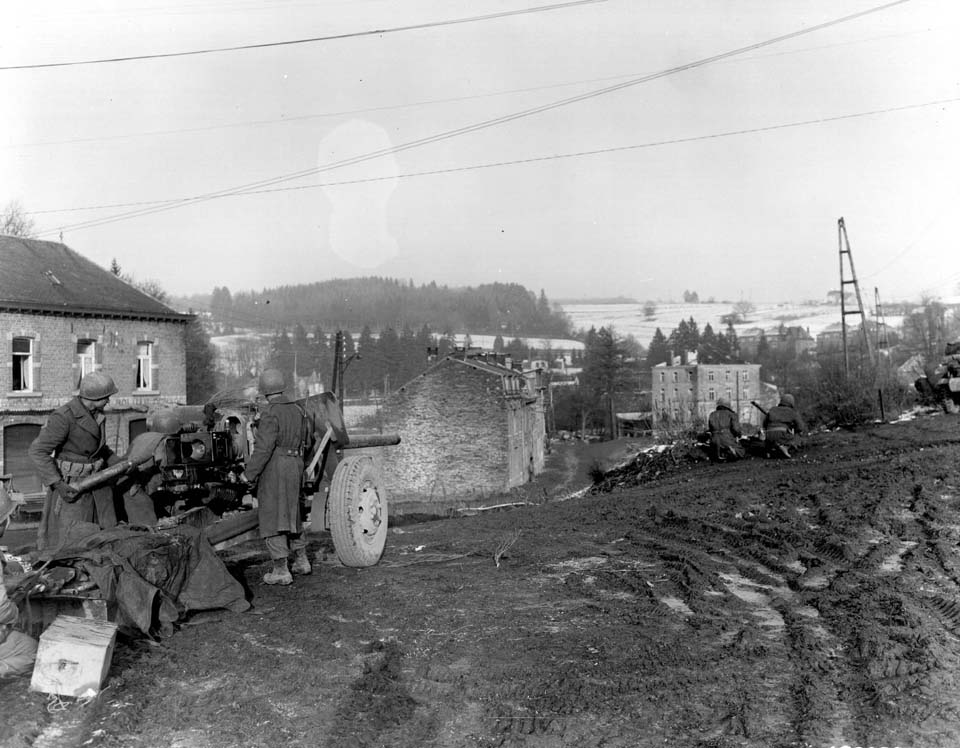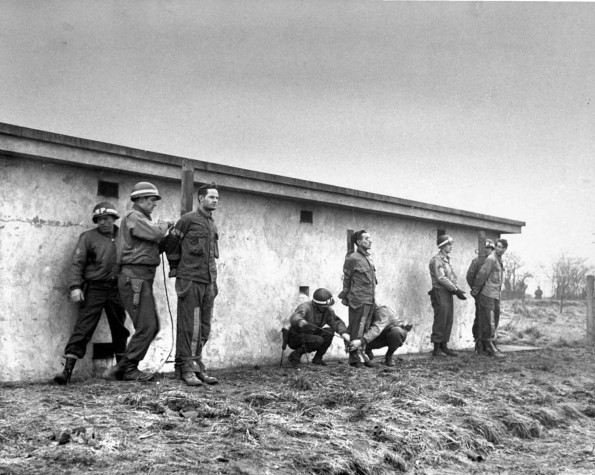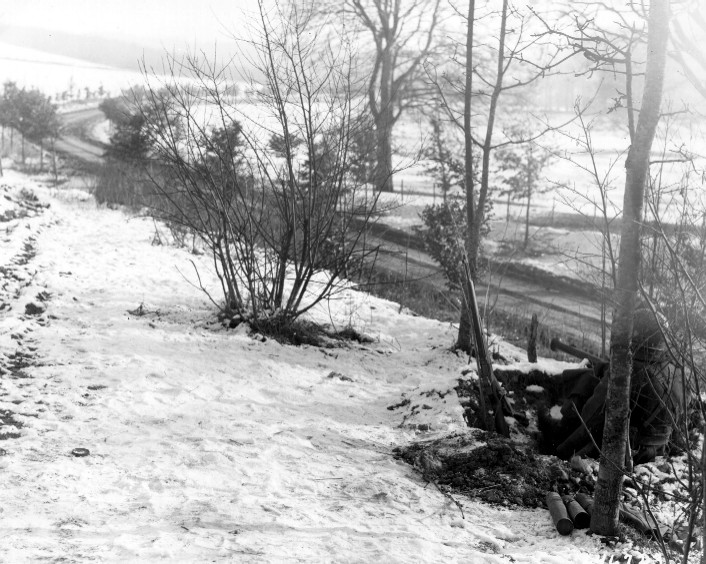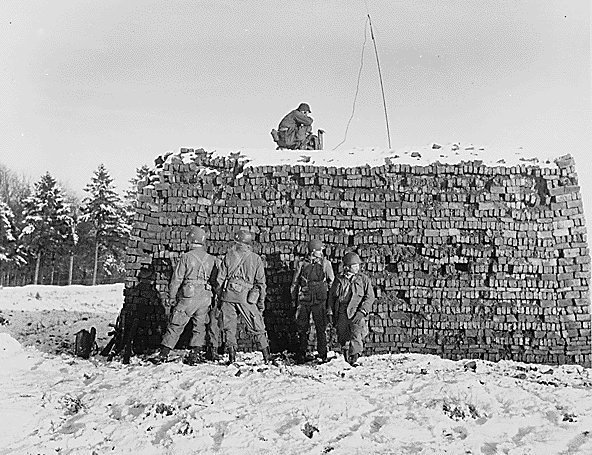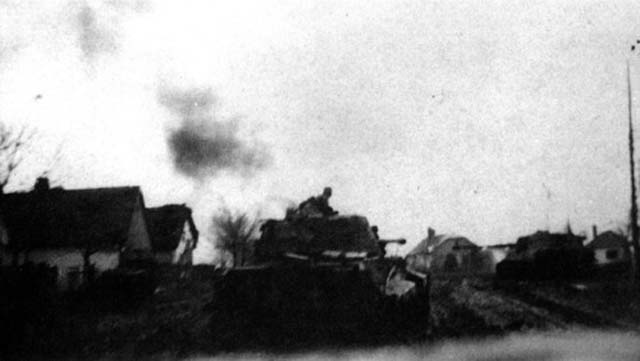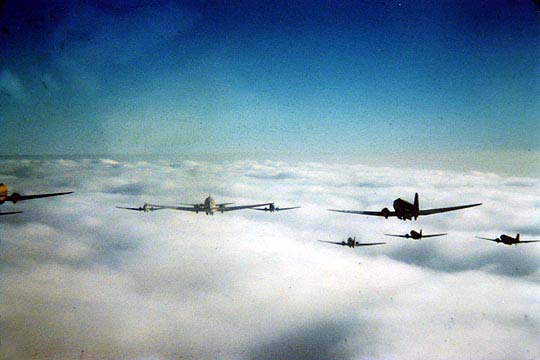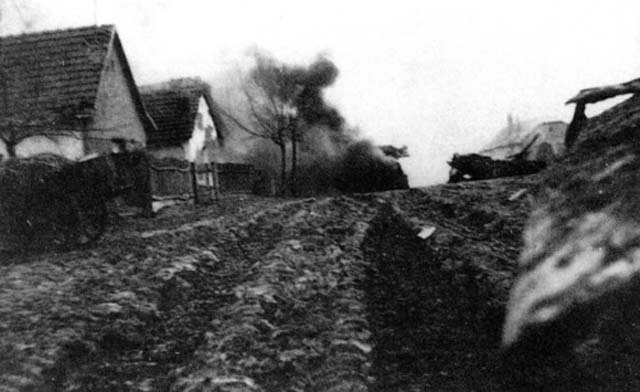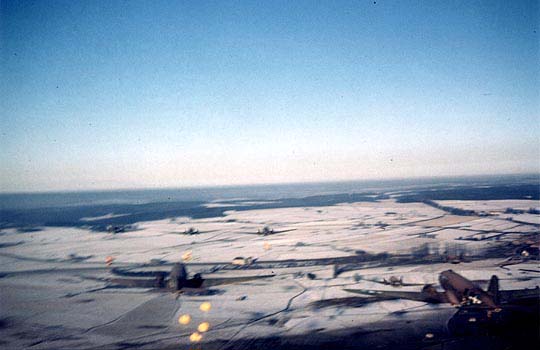Air Operations, CBI
BURMA- 12 10th Air Force B-25s attack bridges at 4 locations.
- More than 40 10th Air Force fighter-bombers attack defended areas, troops, and stores at 5 locations.
- 15 P-47s attack bridges at 3 locations.
- 8 14th Air Force B-25s attack targets along the Burma Road.
- 12 P-51s and P-38s attack the airfield at Heho.
- 3 341st Medium Bomb Group B-25s and 5 14th Air Force P-40s attack rail cars near the Yellow Sea.
- 12 P-51s attack Houmachen with napalm and bomb rail shops at Chenghsien.
- 16 118th Tactical Reconnaissance Squadron P-51s based at the airfield at Suichwan mount a skip-bombing attack against the Wuchang–Hankow ferry terminal.
- 118th Tactical Reconnaisaance Squadron P-51s down 8 Ki-43 'Oscar' fighters over the Ehr Tao Kow airfield at Chiuchiang and the Wuchow satellite field at 1222 hours.
- 23rd Fighter Fighter Group P-51s down 1 Ki-43 'Oscar' fighter and 1 E13A 'Jake' reconnaissance plane over Hong Kong at 0800 hours.
- A 311th Fighter Group P-51 downs a Ki-43 'Oscar' fighter near Chenhsien at 1130 hours.
- 13 341st Medium Bomb Group B-25s attack rail lines, towns, and targets of opportunity at Vinh and on both sides of the China–Indochina frontier.
Air Operations, East Indies
FEAF fighter-bombers attack targets on Halmahera.
[Air Operations, Europe
- The Allied Tactical Air Forces fly 900 sorties against German armor and motor transport in the 'Bulge'.
- 26 V-2s explode in Antwerp.
Daylight Ops:
- 153 Lancasters of No. 3 Group attempt to attack the Trier railway yards through cloud. The bombing appears to be accurate and concentrated but Trier can only report that it is the town's worst raid of the war.
- 1 Lancaster is lost.
- 27 Lancasters and 3 Mosquitos of No. 8 Group are sent to attack the Gremberg railway yards in Cologne. The raid goes very badly. The force is split into 3 formations, each led by an Oboe-equipped Lancaster with an Oboe Mosquito as reserve leader. During the outward flight, 2 Lancasters of No 35 Squadron collide over the French coast and their crews are all killed. On approaching the target, it is found that the cloud which had been forecast has cleared and it is decided to allow the bombers to break formation and bomb visually.
This move is made because the formations would have been very vulnerable to Cologne's flak defences during the long, straight Oboe approach. Unfortunately the order to abandon the Oboe run does not reach the leading Lancaster, a No 582 Squadron aircraft piloted by Squadron Leader R. A. M. Palmer, DFC (on loan from No 109 Squadron), who continues on with his designated role, even though his aircraft is already damaged by flak. German fighters, which are being directed to intercept an American bomber force, also appear and attack. The bombs from Squadron Leader Palmer's aircraft are eventually released and hit the target, but his plane goes down out of control and only the tail gunner escapes by parachute.
Squadron Leader Palmer, on his 110th operation, is awarded a posthumous Victoria Cross, the only Oboe VC of the war. The formation suffers further losses when another Lancaster and a Mosquito are shot down by flak and fighters and a further Lancaster has to be abandoned by its crew over Belgium.
- Total losses for the raid are 6 aircraft out of the 30 sent.
Minor Ops:
- 52 Mosquitos are sent to the Limburg railway yards, 40 to Siegburg, and 7 on 'training flights' to Bremen, Hannover, Münster and Osnabrück, 6 aircraft are on Resistance operations, and 62 aircraft of No. 100 Group make Mosquito patrols and RCM sorties. Each of the Mosquitos shown as being on 'training flights' visits all 4 targets and drops 1 bomb on each. These operations later become known as 'siren-sounding tours'.
- There are no losses.
GERMANY:
- Despite bad weather, 148 1st Bomb Division B-17s, 106 2nd Bomb Division B-24s, and 143 3rd Bomb Division B-17s are able to attack communications centers, rail junctions, marshalling yards, and other transportatin targets in western Germany.
- 163 VIII Fighter Command fighters sweep the Bonn area.
- 1 heavy bomber and 7 of 592 VIII Fighter Command escorts are lost.
BELGIUM:
- 260 IX Troop Carrier Command C-47s, escorted by 3 XIX TAC fighter groups, drop critically needed supplies to the US 101st Airborne Division at Bastogne.
- 8 C-47s are downed by flak.
- On the first reasonably good weather day in a week, 9th Air Force fighters and fighter-bombers mount 696 effective combat sorties, the bulk of them in support of US Army ground forces in and around the Bulge battle areas.
- 19 9th Air Force fighters are lost.
- 8th and 9th Air Force fighter pilots down 133 Luftwaffe fighters and 1 Ju-88--of an estimated 800 Luftwaffe sorties--between 0915 and 1600 hours.
- During the morning, nearly 400 9th Bomb Division B-26s, A-26s, and A-20s attack communicatiions targets and villages in western Germany, directly to the rear of German Army forces engaged in the Ardennes offensive.
- During the afternoon, approximately 200 9th Bomb Division bombers return to the area to attack many of the same or similar targets.
- 35 bombers are lost, the highest one-day bomber loss sustained by the 0th Air Force in the entire war.
ITALY:
- The entire 15th Air Force and all 12th Air Force medium bombers are grounded by bad weather, but XXII TAC P-47s attack rail targets in the Po River valley and an airfield near Milan.
Air Operations, Philippines
- 494th Heavy Bomb Group B-24s based at the airfield at Angaur attack Grace Park Field on Luzon.
- FEAF B-24s attack the Fabrica and Silay airfields on Negros.
- V Bomber Command B-25s attack the Davao and Zamboanga areas, and the San Roque airfield on Mindanao.
- V Fighter Command fighter-bombers attack numerous targets across the central Philippines.
- 12 P-40s directly support a US Army ground force on Leyte.
- 14 P-40s and 5 P-47s mount pre-invasion strikes against ground targets at Palompon, Leyte. The attacks at Palompon mark the first use of napalm by V Fighter Command aircraft.
- A VMF-115 F4U and a VMF-211 F4U share in the downing of an A6M Zero over Golo Island at 1110 hours.
Air Operations, Volcano Islands
26 VII Bomber Command B-24s attack Iwo Jima.
[Allied Planning
The JCS, fearing future entanglements in the Balkans, refuses to authorize the CCS to approve any unilateral British military action in Greece.
[Burma
In the British XXXIII Corps sector, the 19th Indian Div occupies Kokoggon. The 74th Bde of the 25th Indian Div takes Donbaik on the approaches to Akyab Island. Meanwhile, the 81st and 82nd West African Divs have advanced southeast to Muohaung, isolating Akyab from the bulk of the Japanese 28th Army.
[Eastern Front
The battle of Budapest continues. The city is three-fourths surrounded by the 2nd and 3rd Ukraine Fronts.
SOUTHERN SECTORThe 3rd Ukrainian Front tears a 60-mile hole in the 6th Army. Szekesfehervar and Bicske fall as the 4th Guards and 46th Armies push north toward Esztergom. Fierce counterattacks by the 8th Panzer Division are pushed aside. By dusk the fighting has spread into Esztergom, leaving only a narrow corridor open to the west. The 4th Guards Army, supporting the attacks of the 46th Army, sever roads and railway lines out of the city. Erd falls after serious fighting.
[Pacific
The US submarine Blenny (SS-324), despite the presence of escort vessels, sinks the Japanese merchant tanker Kenzui Maru (4156t) off San Fernanto.
[Philippines
On Leyte the guns of the US 77th Div and aircraft of the 5th Air Force hammer Palompon, on the west coast, in preparation for an imminent landing. The Japanese launch their usual night counter-attacks, which are repulsed.
[United States, Home Front
All horse-racing is banned to save labor.
[United States, Planning
The V Amphibious Corps planning staff issues its plan for the invasion of Iwo Jima. The V Amphibious Corps commander, Maj-Gen Harry Schmidt, directs a two-division landing on the southeast side of the island. The 5th Marine Division, commanded by Maj-Gen Keller E. Rockney, will land on the left, and the 4th Marine Division, commanded by Maj-Gen Clifton B. Cates, will land on the right. The 3rd Marine Division, commanded by Maj-Gen Graves B. Erskine, will be in reserve. The two divisions will attack to capture the lower airfield, Mount Suribachi, and gain control of the lower western half of the island before pivoting north and east to capture the rest of the island. Expecting heavy counterattacks on the first night, the marines pland to land as much artillery as possible early to eliminate the threat.
Adm Raymond A. Spruance commands 5th Fleet. Vice-Adm Richmond Kelly Turner commands the expeditionary forces. Rear-Adm Harry W. Hill commands the Attack Force, and Rear-Adm William H. P. Blandy commands the Amphibious Support Forces (demolitions, prelanding air and naval bombardment). Lt-Gen Holland M. Smith, commander of Fleet Marine Forces Pacific, serves as commander of expeditionary troops.
[Western Front
Although Bastogne still holds out against repeated German attacks they have been able to send forces past the town to advance to the west and northwest. These attacks are now beyond Rochefort and Laroche but have neither the necessary strength nor the logistical backing because of the blocks behind them and the growing effectiveness of the Allies air interdiction.
[Images from December 23, 1944
|
|
|
|
|
|
|
|
|
|
|
|

